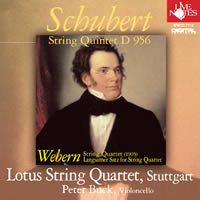
TEL : +81(0) 72 887 2560 / FAX : +81(0) 72 887 2561
[Tokyo-Office]1-24-7-408 Shinjuku Shinjuku-ku,Tokyo, 160-0022, Japan
TEL : +81(0) 3 5379 3733 / FAX : +81(0) 3 3353 6881
[KCM Ticket Service] +81(0) 570 00 8255
[KCM Artist Service] +81(0) 90 3727 6539
| Lotus String Quartet Schubert Review | |||
 |
|||
| Schubert: STRING Quintet
D956 Lotus String Quartet / Cello : Peter Buck [Live notes (D)WWCC7713] JPY2835 Amazon |
|||
The Record Geijutsu , March 2013
Monthly review of new releases Chamber music - Special Selection CD
Akira TAKAHASHI Recommended
The Lotus String Quartet, who give us outstanding performances of the two works in Brahms' String Quartets Op. 51, which I wrote about in this column in the previous edition of this periodical, appears again this month with Schubert's String Quintet. The cellist performing together with the quartet is Peter Buck, former teacher of the Lotus String Quartet, member of the Melos Quartet Stuttgart, and now a professor at the State University of Music and the Performing Arts Stuttgart. Although this has been mentioned before, Schubert, apparently seeking a more powerful bass sound, did not employ two violas in his string quintet as was typical for works by Mozart, but looking to the precedent set by Boccherini, employed two cellos, resulting in the creation of the String Quintet in C major.
By getting a top-tier cellist like Peter Buck, the Lotus String Quartet comes closer to the image of Schubert. The performance is outstanding, and the rich sound of the lower registers brought forth by the two cellos is strongly persuasive. The expression is abundant even in tutti, and the stable yet beautiful sound during the performance of the theme in particular leaves an impression, where the second cello brings out a natural flow which blends into the ensemble in all passages. This performance, which fully makes the most of the profound emotion reflected in the theme of the second movement, stimulates the imagination of the listener. The two works of Webern also included in the CD are surely welcomed as there have not been any new recordings for some time. The subtle changes of harmony borne from the intricate structures are readily understood and the musical passages appearing in each part, although short, are performed with a wealth of expression.
Masao MINEO [Recording critic]
This recording is from the same session in Heidelberg as that of the CD of the works of Brahms released last month. Thus the tone and character are the same, and with a pyramid-shaped full middle and lower range sound, each instrument could be clearly heard because of the short reverberation. However, this time the fullness of the lower range tended to be heavy overall, perhaps because of there being two cellos in the quintet performance. Although this heaviness could have been indicated in the composition, I'll have to subtract one point compared to last time.
Masazumi OHKI Recommended
More new music by the Lotus String Quartet has appeared in rapid succession. This CD was recorded in June 2011, about six months earlier the Brahms CD which I discussed last month. The performance time is about 55 minutes, and although it would not have been unusual to release only the Schubert work, this CD also includes two Webern works. And happily all performances are extremely amazing.
In the Schubert String Quintet, Peter Buck, formerly a cellist for the Melos quartet, is a guest performer, but the musical touch and colour belonged to the Lotus String Quartet throughout. Listening to the ensemble with their flexible and transparent crisp bounce, I recalled all of Schumann's string quartets works, and before I knew it I was excited to be transported to a world as fresh as newly picked fruit. The Arcanto String Quartet very recently released this work on a formidable CD, but in the beauty of this particular music, the Lotus String Quartet disc is also by no means inferior at all, especially in the second movement. I can only say that the fragile beauty of the motif was splendid in that there was not a moment of slack in the quiet sustain of strength leading to this slow movement which flows onwards as if flickering, not knowing when it would come to its end.
And what beautiful music by Webern! I found myself enraptured of course with the charmingly fascinating Langsamer Satz trickling with romance (couldn't ask for a better work!), as well as the entirely elaborate and meticulous string quartet work.
| Artist News | Top Page |